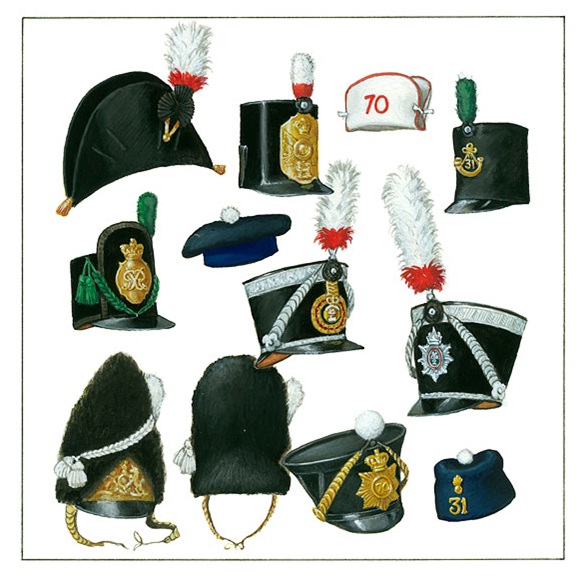- 17th and 18th Centuries
- 19th Century. First Half
- 19th Century. Second Half
- 20th Century
Headress History
19th Century. First Half.

19th Century. First Half.
Top row: Officers hat 1800, Shako 1800, Forage cap 1806, shako 1806-1812. Second row: Shako 1812, Forage cap 1815, Shako 1816, Shako 1820. Bottom row: Grenadier caps 1816, 1835. Shako 1828, Forage cap (Kilmarnock) 1834.
After Waterloo military fashions ran riot with decoration taking precedence over practicality and comfort. Foot Guards wore bearskins (the latest version of the grenadier cap) which were so high that taller sentry boxes had to be installed to accommodate the wearers. In cavalry regiments Lancers wore Polish style uniforms with square topped caps while Hussars adopted the Continental type busby. The Household Cavalry appeared in bright steel helmets with fur crests so high that they could barely be kept on the head.
Infantry regiments discarded their Waterloo shakos in 1816 for an improved ‘Prussian’ style of black felt with a glazed top which was slightly wider at the top and with a peak at the front and the back. This soon evolved into the Regency shako much wider at the top and rather bell shaped. Regimental lace, in silver or gold, decorated the top and bottom edges of this shako. It was quite heavy. As extravagance became rife so the shako, although it lost its regimental lace, soon became festooned with cords and with ridiculously long feathers. By 1844 the authorities had had enough and ordered the removal of excessive lace from the uniforms and introduced a new shako. Supposedly designed by Prince Albert, the new shako (called the ‘Albert’) was almost a reversal to the original shape. It was tall and cylindrical with a leather top and with a peak before and behind. The badge, which had evolved over the years, was the same as that worn on the bell topped shako. During the Crimean war the Albert proved impractical for active service and the round, undress, Kilmarnock forage cap was worn by most of the regiments engaged. The shako remained for full dress.
Copyright 2014 Linkorient.com. All Rights Reserved





 ++84 (0) 912.278.988
++84 (0) 912.278.988
